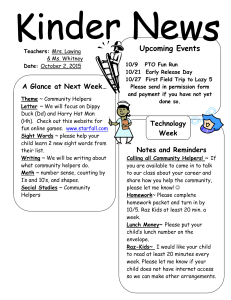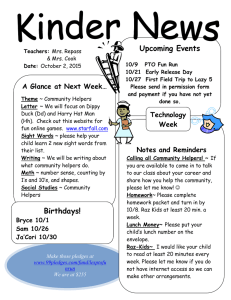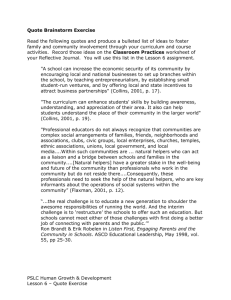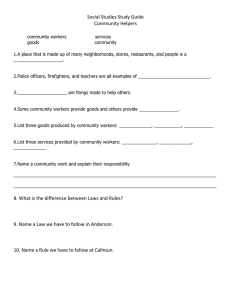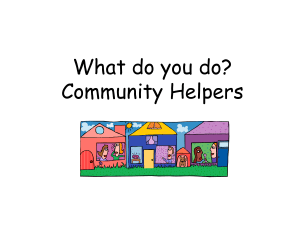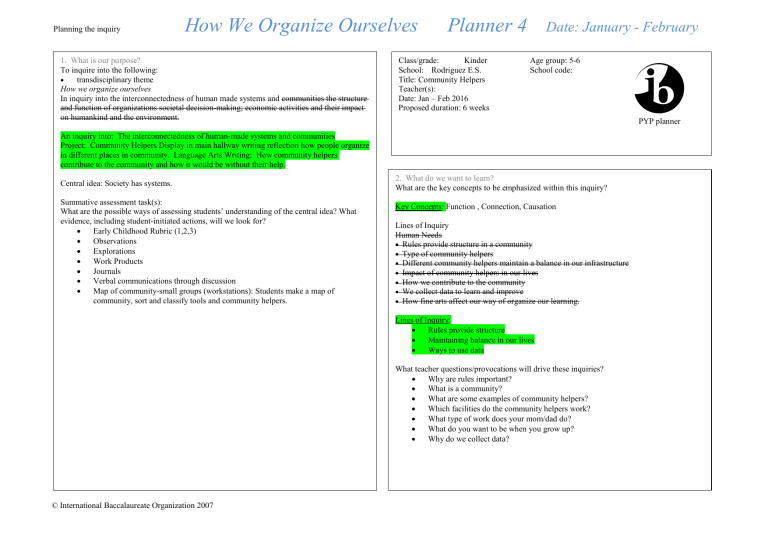
Planning the inquiry How We Organize Ourselves 1. What is our purpose? To inquire into the following: • transdisciplinary theme How we organize ourselves In inquiry into the interconnectedness of human made systems and communities the structure and function of organizations societal decision-making; economic activities and their impact on humankind and the environment. Planner 4 Class/grade: Kinder School: Rodriguez E.S. Title: Community Helpers Teacher(s): Date: Jan – Feb 2016 Proposed duration: 6 weeks Date: January - February Age group: 5-6 School code: PYP planner An inquiry into: The interconnectedness of human-made systems and communities Project: Community Helpers Display in main hallway writing reflection how people organize in different places in community. Language Arts Writing: How community helpers contribute to the community and how it would be without their help. Central idea: Society has systems. Summative assessment task(s): What are the possible ways of assessing students’ understanding of the central idea? What evidence, including student-initiated actions, will we look for? • Early Childhood Rubric (1,2,3) • Observations • Explorations • Work Products • Journals • Verbal communications through discussion • Map of community-small groups (workstations): Students make a map of community, sort and classify tools and community helpers. 2. What do we want to learn? What are the key concepts to be emphasized within this inquiry? Key Concepts: Function , Connection, Causation Lines of Inquiry Human Needs • Rules provide structure in a community • Type of community helpers • Different community helpers maintain a balance in our infrastructure • Impact of community helpers in our lives • How we contribute to the community • We collect data to learn and improve • How fine arts affect our way of organize our learning. Lines of Inquiry: • Rules provide structure • Maintaining balance in our lives • Ways to use data What teacher questions/provocations will drive these inquiries? • Why are rules important? • What is a community? • What are some examples of community helpers? • Which facilities do the community helpers work? • What type of work does your mom/dad do? • What do you want to be when you grow up? • Why do we collect data? © International Baccalaureate Organization 2007 Planning the inquiry 3. How might we know what we have learned? This column should be used in conjunction with “How best might we learn?” What are the possible ways of assessing students’ prior knowledge and skills? What evidence will we look for? • Small and whole group discussions • Discussions about what they have observed in the world around them. • Describe past events in their lives • Discuss and describe community helpers they have seen in the world around them. • KWL Chart What are the possible ways of assessing student learning in the context of the lines of inquiry? What evidence will we look for? • Students will be expected to participate in take home projects. They will have to make a connection and tell how the community helpers relate or help them in the community (take pictures, draw pictures, use magazines/newspapers, etc.) • Participate in classroom jobs and contribute to the classroom community. • Show sense of responsibility for individual behavior and actions. 2016-2017: Students will be exposed to data analysis, for example: They can collect information in class or at home and then analyze. Students will be expected to ask and answer questions related to the data they collected. © International Baccalaureate Organization 2007 4. How best might we learn? What are the learning experiences suggested by the teacher and/or students to encourage the students to engage with the inquiries and address the driving questions? • Draw a picture in writing journal about what the student wants to be when she /he grows up • Career day - Invite a community helper to talk to the class • Bring a picture and interview a relative that helps the community • Talk about our classroom responsibilities and jobs • Make a class book about community helpers • Have students bring in objects or pictures of items used by various community helpers to build vocabulary • Create graphs based on data collected in school or their home. What opportunities will occur for transdisciplinary skills development and for the development of the attributes of the learner profile? • Students will identify similarities and differences among different community workers (thinker, knowledgeable, Inquirer) • Students will use simple tools for analyzing data and information. (Inquirer) • Students will describe different types of rules and systems for different community helpers in the world around them. (Thinker, Knowledgeable, communicator) • What are the advantages of having community helpers/systems/rules? (Thinker, Knowledgeable) Reflecting on the inquiry 5. What resources need to be gathered? What people, places, audio-visual materials, related literature, music, art, computer software, etc, will be available? • Community helper speakers such as school nurse, librarian, principal, etc… • Field trip to a place in the community such as the Rodeo or Zoo • Collect various books on community helpers to place in class library and to read to students • Websites such as united streaming and discovery kids How will the classroom environment, local environment, and/or the community be used to facilitate the inquiry? Community Helpers inside and outside the school will be utilized such as the classroom (small group, whole group, workstations), Science Lab, playground and school grounds. • Draw a picture in writing journal about what the student wants to be when she /he grows up • Career day - Invite a community helper to talk to the class • Bring a picture and interview a relative that helps the community • Talk about our classroom responsibilities and jobs • Make a class book about community helpers • Have students bring in objects or pictures of items used by various community helpers to build vocabulary • Surveys that guide students to ask questions to their family and gather data. 6. To what extent did we achieve our purpose? Assess the outcome of the inquiry by providing evidence of students’ understanding of the central idea. The reflections of all teachers involved in the planning and teaching of the inquiry should be included. Students were able to become more familiar with various aspects of community helpers such as uniforms, tools used by each helper, and the places where they work. Students were also able to become aware of less familiar community workers and increase their vocabulary. Students learned why each worker is important and how they contribute to the community. The students learned what would happen if a particular worker did not do their job. Students were able to connect outside community workers with community workers in the school. Connections were also made through classroom discussions and activities. Students learned the importance of staying organized to avoid chaos in a community environment. We discussed the importance of people’s needs and wants and the important role that everyone has in the community. Students had a chance to pick what they would like to grow up and draw a picture of themselves in the community helper’s attire. Project: Community Helpers Display in main hallway writing reflection how people organize in different places in community. Language Arts Writing: How community helpers contribute to the community and how it would be without their help. 2016-2017 Students collected and displayed different types of data (collected from home) like number of family members, languages spoken at home, country of origin, number of siblings. Students could analyze the data and compare their information with peers in whole group. How you could improve on the assessment task(s) so that you would have a more accurate picture of each student’s understanding of the central idea. Show and Tell activities Use different scenarios such as what would we do if there were no community helpers…. Have real/actual community helper come in and speak Students will have a gallery walk opportunity that would allow them to interview other students from other kinder classes that will be role playing a community helper. (Each classroom will be designated a particular community helper to role play) 2016-2017: Let students individually write the outcome about the analysis of the data and compare it to their peers. At the end, students can share their findings in whole group. What was the evidence that connections were made between the central idea and the transdisciplinary theme? The students were able to provide evidence that connections were made between the central idea and the transdisciplinary theme by presenting their take home research projects and demonstrating the needs of having a society that is composed of rules and systems. 2016-2017:The students were able to make connection through the use of vocabulary related to community, organization, and the meaning of what a system means. The students were able to explain rules and structures that are embedded in a system to make the society function. © International Baccalaureate Organization 2007 Reflecting on the inquiry 7. To what extent did we include the elements of the PYP? What were the learning experiences that enabled students to: • Develop an understanding of the concepts identified in “What do we want to learn?” Connection: Students discovered that we have systems everywhere, for example, they could explain that the grocery store is organized, so people can find what they need to buy. Function: Students understood people in the community help each other to stay healthy and safe. Responsibility: Students understood the importance of making good choices, following rules, being good citizens and leaders in the classroom community as well as the outside community. Form: Students identified and described the jobs of various community helpers and categorized the tools they used the places they work. 2016-2017 Connection: The students could explain that rules have a purpose in society. Function: The students could identify community helpers, and the importance of their contributions to the community, the function and importance of data in society. Causation: The students described how people needs from each other to make society function. • How did students demonstrate the learning and application of particular transdisciplinary skills? Thinking Skills: Students applied their background knowledge using graphic organizers and extended this knowledge by recognizing similarities and differences amongst communities and people’s jobs. Social Skills: Being able to cooperate with their peers during small group workstations, participate in classroom jobs and work as a classroom community. The students demonstrated cooperation when they analyze their data and compare it to their peers. Communication Skills: Students took turns listening and presenting their books and graphic organizers. Students participated in inquiries and discussions in class, and they could compare • Students developed attributes of the learner profile and/or attitudes? Communicators: Students shared verbally and communicated the importance of community helpers and identified their roles. Principled: Students learned the responsibilities of community helpers and how they impact everyday life. Balanced: Identify how community helpers keep us safe, healthy, and organized. Knowldegable: Students gathered data collected from home, for example, country of origin, number of siblings, language spoken at home, and they concluded that we all have differences and similarities by collecting data and plugging it into a graph. © International Baccalaureate Organization 2007 8. What student-initiated inquiries arose from the learning? Record a range of student-initiated inquiries and student questions and highlight any that were incorporated into the teaching and learning. • What is a community? • Who built our school? • Is the pharmacists the same as a doctor? • Does a veterinarian help lions too? • What is the difference between a doctor and a veterinarian? • Do all communities have the same helpers? • Who is our mayor? • If I become a reporter will I be on TV? Students’ initiated questions? • Why is there water on top of the grass? • Do worms have eyes? I can’t find them. • How do dentist organize themselves? • How do firemen help people who are stuck in the car? • Why is Ms. Key not the doctor? School nurse because she wears scrubs. 2016-2017 • What is a graph? • Where is Honduras? • Do stores in another country like stores in Houston? • Do stores in another country organize products in the same way as here? • At this point teachers should go back to box 2 “What do we want to learn?” and highlight the teacher questions/provocations that were most effective in driving the inquiries. What student-initiated actions arose from the learning? Record student-initiated actions taken by individuals or groups showing their ability to reflect, to choose and to act. Students initiated spontaneous dramatic play of the community helpers and making connections in the different workstations; such as read to self, read to someone, etc. During whole group, students could explain that a non-fiction book has a table of content that helps to find information in the book, just like if you go to the store and want to find something to buy. Students explained that we have rules everywhere and one of them stood up and said that he has rules at home. 9. Teacher notes As a Technology Class, guided lessons along with the use of computers and software such as Education City Science will provide our students with the multiple opportunities to be exposed to diverse and meaningful interactions between the natural world and human societies. Also, our students will be able to comprehend how human behavior impacts our planet. Students will develop and portray characters with voice, body, and gesture… cont. performance in drama situations. Function: How does the character move? Causation: How do we know when a story or play is finished? Reflection: (retelling a familiar story) what are your favorite /special memories of childhood? Activities: Game: “Add-on” Students will improve acting and memory skills by incorporating multiple actions to characters (while moving across an open space.) Character Add-on #1 Add-on #2 Pirates catching a big fish with poison ivy Mad Scientists with stomach aches playing freeze tag Disco dancers with itchy backs need to use the bathroom Jugglers on skateboards yodeling Ghosts snowboarding singing opera Next Year Initiative: We will incorporate Language Arts Reading lessons within our IB planners. For example “When I Grow Up”- Community Helpers, etc. © International Baccalaureate Organization 2007

